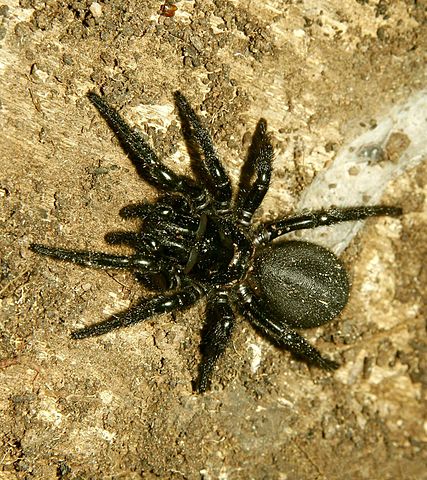You do not want to come into contact with a Sydney funnel-web spider.
- Sydney funnel-web spiders are venomous arachnids, endemic to the developed and forested habitats of the Sydney area, in Australia’s state of New South Wales.
- The scientific name of Sydney funnel-web spiders is Atrax robustus and it is from the family Hexathelidae, a family of funnel-web spiders, and they are also commonly known as ‘Sydney funnelweb spiders’ or simply ‘funnel-web spiders’.
- The body of a Sydney funnel-web spider generally grows to be 1.5 to 3.5 centimetres (0.6 to 1.4 inches) in length, and males are usually smaller than females.
- The Sydney funnel-web spider is coloured brown, black, dark purple or navy and it has a shiny cephalothorax (head and thorax), and a hairy abdomen and legs.
- Sydney funnel-web spiders will easily dehydrate in sun, and thus require rest in moist, shaded areas during heated parts of the day.
Sydney Funnel-web Spider
Image courtesy of Wikimedia Commons
- The venom of Sydney funnel-web spiders can be fatal to primates, including humans, causing negative effects towards the nervous system, and mature males are more potent than females and young spiders.
- An anti-venom for Sydney funnel-web spiders surfaced in 1980, devised in Melbourne’s Commonwealth Serum Labs by a team led by Australian Struan Sutherland, which was first used in January 1981, saving the life of Sydney patient Gordon Wheatley, after he was bitten.
- A Sydney funnel-web spider will display its particularly large fangs and rear on its hind legs when feeling endangered, potentially striking with a number of bites.
- The Sydney funnel-web spider lives in sandy or earthy burrows, typically with a funnel or conical shaped entrance that it surrounds and lines with a silk web that acts as a trip wire, which notifies the spider of its potential meal of insects, small reptiles and amphibians.
- Sydney funnel-web spiders can survive in water for up to 24 hours or more, as the hairs on their legs and body produce air pockets, and as such, they can be found alive in domestic swimming pools.
Bibliography:
Gray M, Sydney Funnel-web Spider, Atrax Robustus, 2015, Australian Museum, http://australianmuseum.net.au/sydney-funnel-web-spider
Sydney Funnel-web Spider, 2010, Australian Reptile Park, http://www.reptilepark.com.au/animalprofile.asp?id=126
Sydney Funnel-web Spider, 2015, Wikipedia, https://en.wikipedia.org/wiki/Sydney_funnel-web_spider







